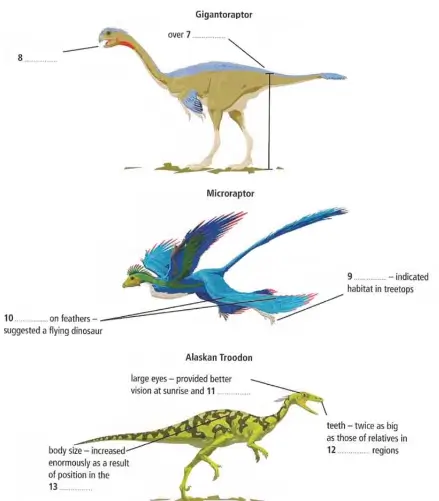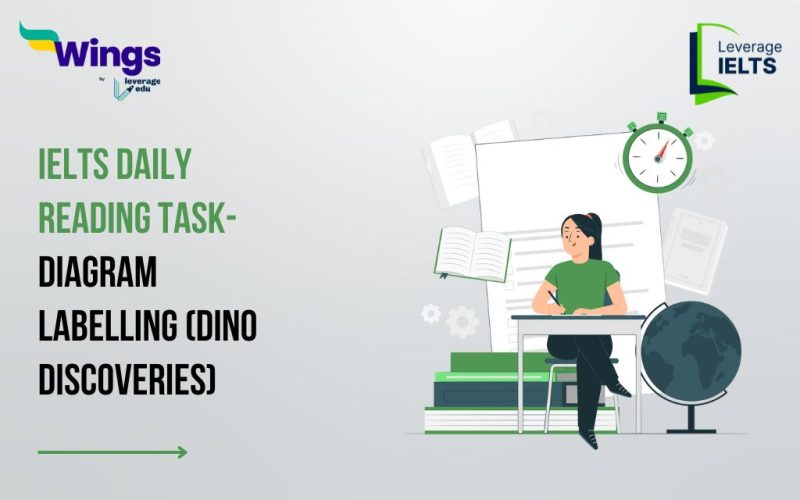Diagram labelling questions in the IELTS reading test require you to label or complete a diagram, chart, or map based on information provided in the text. Read the Passage and Answer Accordingly.
Dino Discoveries
“When news breaks of the discovery of a new species of dinosaur, you would be forgiven for thinking that the scientists who set out in search of the fossils are the ones who made die find. The reality tells a different story, as Cavan Scott explains.
The BBC series Planet Dinosaur used state-of-the-art computer graphics to bring to life the most impressive of those dinosaurs whose remains have been discovered in the past decade. One of these is Gigantoraptor erlianensis. Discovered in 2005. it stands more than three metres high at the hip and is the biggest bird-like dinosaur ever unearthed Yet its discoverer. Xu Xing of Beijing’s Institute of Vertebrate Palaeontology and Paleoanthropology was not even looking for it at the time. He was recording a documentary in the Gobi Desert. Inner Mongolia.
‘The production team were filming me and a geologist digging out what we thought were sauropod bones.’ says Xu. ‘when I realised the fossils were something else entirely.’ Gigantoraptor, as it later became known, turned out to be an oviraptorid, a therapod with a bird-like beak. Its size was staggering. The largest oviraptorid previously discovered had been comparable in size to an emu: the majority were about as big as a turkey. Here was a creature that was probably about eight metres long, if the bone analysis was anything to go by.
Sometimes it is sheer opportunism that plays a part in the discovery of a new species. In 1999. the National Geographic Society announced that the missing link between dinosaurs and modern birds had finally been found. Named Archaeoraptor lianoingensis. the fossil in question appeared to have the head and body of a bird, with the hind legs and tail of a 124-million-year-old dromaeosaur – a family of small theropods that include the bird-like Velociraptor made famous by Jurassic Park films.
There was a good reason why the fossil looked half-bird, half-dinosaur. CT scans almost immediately proved the specimen was bogus and had been created by an industrious Chinese farmer who had glued two separate fossils together to create a profitable hoax.
But while the palaeontologists behind the announcement were wiping egg off their faces, others, including Xu were taking note. The head and body of the fake composite belonged to Yanornis martini, a primitive fish-eating bird from around 120 million years ago. The dromaeosaur tail and hind legs, however, were covered in what looked like fine protofeathers. That fossil turned out to be something special. In 2000. Xu named it Microraptor and revealed that it had probably lived in the treetops. Although it couldn’t fly. its curved claws provided the first real evidence that dinosaurs could have climbed trees. Three years later. Xu and his team discovered a closely related Microraptor species which changed everything. ‘Microraptor had two salient features.’ Xu explains long feathers were attached not just to its forearms but to its legs and claws. Then we noticed that these long feathers had asymmetrical vanes, a feature often associated with flight capability. This meant that we might have found a flying dinosaur.’
Some extraordinary fossils have remained hidden in a collection and almost forgotten. For the majority of the 20th century, the palaeontology community had ignored the frozen tundra of north Alaska. There was no way, scientists believed that cold-blooded dinosaurs could survive in such bleak, frigid conditions. But according to Alaskan dinosaur expert Tony Fiorillo. they eventually realised they were missing a trick.
The first discovery of dinosaurs in Alaska was actually made by a geologist called Robert Liscomb in 1961.’ says Fiorillo. ‘Unfortunately, Robert was killed in a rockslide the following year, so his discoveries languished in a warehouse for the next two decades.’ In the mid-1980s, managers at the warehouse stumbled upon the box containing Liscomb’s fossils during a spring clean. The bones were sent to the United States Geological Survey, where they were identified as belonging to Edmontosaurus. a duck-billed hadrosaur. Today, palaeontologists roam this frozen treasure trove searching for remains locked away in the permafrost.
The rewards are worth the effort. While studying teeth belonging to the relatively intelligent Troodon therapod. Fiorillo discovered the teeth of the Alaskan Troodon were double the size of those of its southern counterpart. ‘Even though the morphology of individual teeth resembled that of Troodon. the size was significantly larger than the Troodon found in warmer climates. Fiorillo says that the reason lies in the Troodon’s large eyes, which allowed it to hunt at dawn and at dusk – times when other dinosaurs would have struggled to see. In the polar conditions of Cretaceous Alaska, where the Sun would all but disappear for months on end, this proved a useful talent. Troodon adapted for life in the extraordinary light regimes of the polar world. With this advantage, it took over as Alaska’s dominant therapod.’ explains Fiorillo.
Finding itself at the top of the food chain, the dinosaur evolved to giant proportions.
Some of the most staggering of recent developments have indeed come from palaeontologists being in the right place at the right time, but this is no reflection on their knowledge or expertise. After all, not everyone knows when they’ve stumbled upon something remarkable. When Argentine sheep farmer Guillermo Heredia uncovered what he believed was a petrified tree Irunk on his Patagonian farm in 1988. he had no way of realising that he’d found a 1.5-metre-long tibia of the largest sauropod ever known to walk the Earth. Argenlinosaurus was 24 metres long and weighed 75 tonnes. The titanosaur was brought to the attention of the scientific community in 1993 by Rodolfo Coria and Jose Bonaparte of the National Museum of Natural Sciences in Buenos Aires. Coria points out that most breakthroughs are not made by scientists but by ordinary folk. ‘But the real scientific discovery is not the finding; it’s what we learn from that finding.’ While any one of us can unearth a fossil, it takes dedicated scientists to see beyond the rock.”
Q. Complete the Labels on the Diagrams Below.

Answers:
7. Three metres
8. Bird-like beak
9. Curved claws
10. Asymmetrical Vanes
11. Dusk
12. Warmer
13. Food Chain
Tips To Remember
- Quickly understand the diagram before reading the passage.
- Pay attention to word limits and specific instructions in the question.
- Efficiently scan the text to locate keywords and details related to the diagram.
- Prioritize reading headings and subheadings to find relevant information.
- Skim for general ideas and then scan for specific details matching the diagram labels.
- Look out for synonyms or paraphrased expressions to match diagram labels accurately.
- Ensure the correct forms (e.g., singular or plural) of words are used to fill in the blanks.
- Be mindful of time; move on to the next question if one seems particularly challenging.
- Familiarize yourself with various diagram types through regular, timed practice.
- Check for spelling and grammar errors; ensure choices logically fit the passage context.
Are you preparing for IELTS? Check out this video to improve your reading skills for the IELTS exam given below👇.
Download the Leverage IELTS App today.


Need help to prepare for IELTS? Check out the best IELTS preparation courses in the market offered in a live training environment by trusted educators in a live training environment. If you want help studying abroad, call 1800-572-130.
 One app for all your study abroad needs
One app for all your study abroad needs















 60,000+ students trusted us with their dreams. Take the first step today!
60,000+ students trusted us with their dreams. Take the first step today!